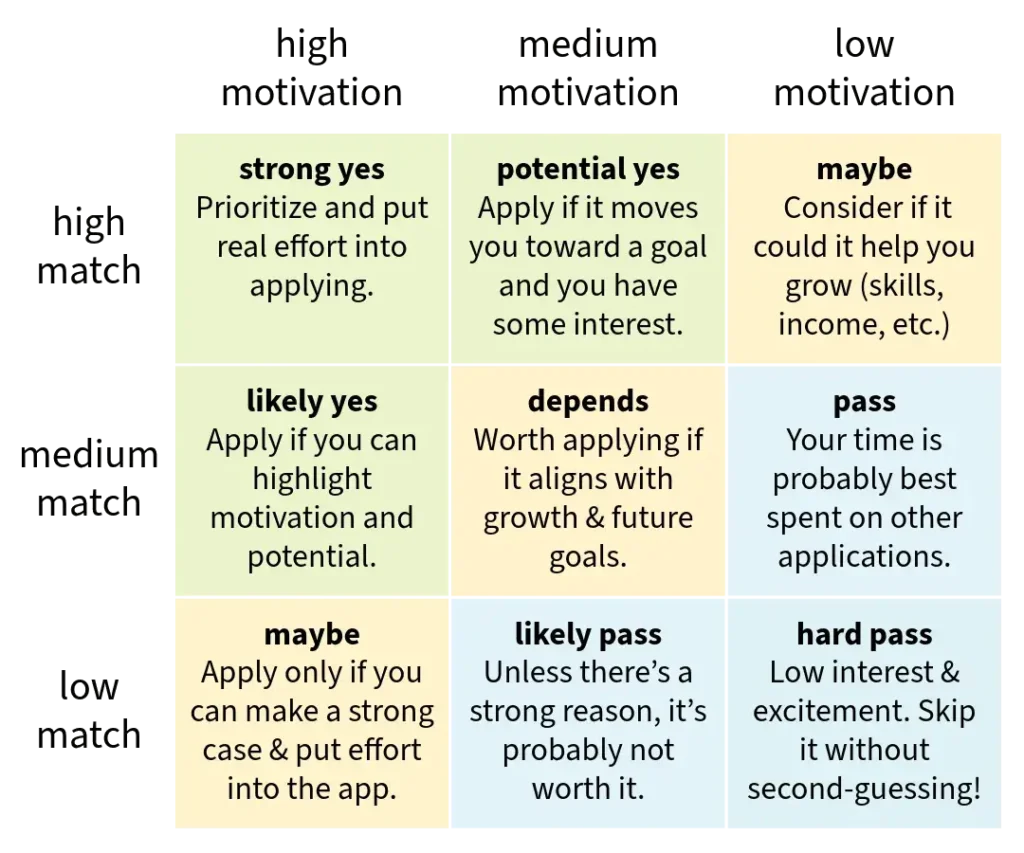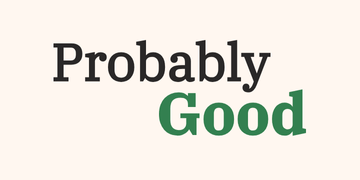Applying for jobs can feel like a full-time job on its own. The process can be overwhelming, especially when it takes dozens—or even hundreds—of applications to land the right opportunity. Without a clear strategy, it’s easy to get discouraged or lose track of your progress. Here’s how to prioritize applications, set achievable goals, and keep up your momentum throughout your job search.
Decide whether to apply
It’s common to either apply to everything you come across or spend too much time worrying about whether each job is perfect. The ideal approach lies in striking a balance—being intentional about your applications while maintaining an open mind.
The main thing to keep in mind is that every application has a time cost (and sometimes a financial or emotional one). Prioritizing roles based on fit and importance helps you allocate energy effectively, including in cases where your time might be better spent on something else, like tailoring another application to a more promising opportunity, networking, or building a valuable skill.
The application matrix
Deciding whether to apply for a job—or spend time pursuing an opportunity—often comes down to two questions:
- Is this right for me? (Motivation)
- Am I right for this? (Match)
The application matrix helps you quickly map out where different opportunities fall within these questions, then assess whether or not it’s worth applying.

Step 1: Think about your motivation
This is about what you want and need from your next role. It’s your internal sense of whether the opportunity excites you and meets your personal priorities. Ask yourself:
- Does this role align with what you’re looking for in your career right now?
- Would it move you closer to the kind of work you ultimately want to be doing?
- Are you genuinely excited about the mission, the day-to-day tasks, and the team?
- Does it meet your needs for compensation, flexibility, growth, and impact?
This is also a good time to think about the impact potential of the role—whether through the work itself or as a stepping stone for the future. Consider whether the role aligns with at least one of these:
- Direct impact. Does the work itself contribute meaningfully to a cause or issue you care about?
- Career capital. Will this role help you build valuable skills, experience, or connections that position you for greater impact in the future?
- Effective giving potential. Could taking this job enable you to donate more to effective charities (if effective giving is part of your plan)?
If the role checks some of these boxes—and you feel personally motivated by it—that’s often a strong signal it’s worth exploring further. If it doesn’t, and you’re not feeling excited, it may not be the best use of your time (even if you think you’d be a competitive candidate).
Step 2: Understand your match for the role
Your match is about how well you fit what they’re looking for. It’s an external measure of whether you’re the kind of candidate who is likely to succeed in the process and thrive in the role. Consider:
- Do your skills, experience, and background line up with the core requirements?
- Can you make a compelling case that you’re a strong match for this specific role?
- Are there practical constraints (location, salary, visa needs) that might complicate the hiring process from the employer’s perspective?
- Does the role align with your current career stage in a way that makes sense to the employer, given your experience and trajectory?
In other words:
- Fit with the role. Are you a good match on paper and in practice?
- Likelihood of success: How competitive are you relative to the typical applicant? Consider factors like how your skills, experience, and achievements compare to those typically required for the role.
- Ease of hiring you. Would the employer see you as a straightforward hire, or would they have to make exceptions or take risks?
High match means you’re well-positioned to get the role. Low match doesn’t automatically rule you out, but it’s something to weigh carefully alongside motivation.
Separating motivation and match helps you make clear-headed decisions about where to spend your time. It’s easy to get pulled into applying for roles just because you’re qualified—or to chase opportunities you’re excited about but aren’t a fit for. This framework helps you balance both perspectives.
And if you use this matrix for other big decisions—like cause areas or career paths—it can give you the same clarity. Motivation = what you want. Match = where you can do your best work.
Categorize roles to focus your effort
Another way to bring clarity and balance to your job search is by categorizing the roles you’re considering. You can think of them in three groups: reach, target, and backup roles. This approach works alongside the matrix strategy, allowing you to assess your opportunities from different angles.
Reach roles
Reach roles are the ones that feel like a stretch—you might not meet every qualification, but you have high motivation for the opportunity and believe you could grow into it. Maybe you’re missing a key requirement or two, but your skills from other experiences could translate well. While these roles are less certain, they can be particularly valuable, so worth going.
To decide if a reach role is worth your time, consider whether you can make a strong case for yourself. Can you clearly explain how your past work, even in a different context, has prepared you for this challenge? If so, apply! Growth often requires calculated risks. Just be realistic—don’t focus too much on long shots, but if a role excites you and aligns with your background, including a few reach roles in your job search can open up new opportunities.
Target roles
Target roles are where you want to put most of your time and energy. You meet most (if not all) of the qualifications, and the role feels like a natural fit for your skills and experience. Think of them as the sweet spot—challenging enough to keep you engaged, but also well within your capabilities.
These are the roles you’re most likely to get, because they match your background and the company’s needs. When you find a target role, take extra care with your application. Tailor your resume and cover letter to really highlight how your experience aligns with what they’re looking for. If you’re putting energy into applying, this is where it’s best spent.
Backup roles
Backup roles are jobs where you meet the qualifications but aren’t as motivated by or they don’t fully match up with your long-term goals. These roles might not be your ideal next step, but they’re still positions you’d be a strong candidate for.
That said, your match for the actual specific role matters just as much as qualifications! If you’re overqualified for a job, it doesn’t necessarily mean it’s a backup. Even if you technically meet the qualifications, employers might wonder if you’d be satisfied with the day-to-day work or if your experience doesn’t align well enough with the nature of the role. Similarly, if you’re passionate about operations but applying for a research position, you’ll need to show that you understand the role and have a genuine interest in making the switch. Backup roles should be a safety net—not your main focus. Keep enough in your pipeline to ensure you have options, but don’t overinvest in roles that don’t excite you or contribute to your broader career goals.
Prioritize your time and effort
After deciding which roles to pursue, it’s helpful to think about how much effort each application deserves. It’s common advice that you should customize your application materials (you should!), but not every application is worth the same level of investment.
Some applications will require more from you than others, whether it’s a work test, detailed short answer questions, or a personality-based assessment. It can be worthwhile to tackle a high-investment application for the sake of practice or if the effort you’re putting in is generalizable to other applications. For example, if you create a portfolio that showcases your best projects or develop a set of strong responses to common interview questions, you can reuse or adapt these materials later.
But when an application requires incredibly specific requests, like creating a work sample that only aligns with that one job’s niche needs or writing a detailed project proposal, you should think about whether the potential payoff justifies the effort. If these unique requirements don’t contribute to materials that could be repurposed for other opportunities, it’s probably best to prioritize roles where the application effort is more broadly useful.
Set clear and achievable application goals
Clear goals can make your job search feel more structured and purposeful, but it’s important to find an approach that works for you. There’s no one-size-fits-all answer for how many jobs you should apply to each week—it depends on your schedule, energy, and how much time you’re putting into each application. The key is to stay focused without becoming rigid. Setting targets can give you a sense of progress, but they should be flexible enough to adjust as you go.
One way to approach this is by setting a simple, measurable goal, like aiming to apply for a certain number of roles each week. If you’re working full-time, three to five applications a week might feel manageable. If you have more time, you might aim for seven to ten. But it’s worth remembering: these numbers are just a guide. There’s no need to force applications just to hit a quota, especially if the roles aren’t a good fit or the effort outweighs the opportunity.
Another option is to focus less on numbers and more on creating a consistent habit.
You might set up job board alerts and check them once a day, only applying to roles that meet a certain bar—whether that’s your target and reach roles, or positions that align with your fit and motivation. This approach can help you stay engaged in the search without pressuring yourself to apply to every vaguely relevant job that comes your way.
It’s also helpful to factor in the time and energy that customization takes. Tailoring your resume, writing thoughtful cover letters, or assembling work samples can add up, especially for competitive roles. If you’re applying for highly selective positions that require more effort, it makes sense to scale back the number of applications and focus on quality over quantity. It’s almost always better to put more energy into a few strong applications than to rush through many weaker ones.
On a more general note, keep an eye on timing for your applications. Some jobs review applications on a rolling basis, so applying early can give you an advantage. Others have firm deadlines, but even then, it’s often better not to leave things until the last minute. Employers will likely still review the applications in the order they came in, so getting yours in earlier on could be helpful.
Track your progress and adjust along the way
When you’re juggling multiple applications, it’s surprisingly easy to lose track of where you’ve applied, what stage you’re at, and which deadlines are coming up. Having a system to keep track of it all doesn’t just prevent things from slipping through the cracks—it can also help you spot patterns and make smarter decisions about how you’re spending your time.
Some people gravitate toward structured tools like Trello, Huntr, or Airtable, which let you create customizable boards for each stage of the process. Others prefer a simple spreadsheet to list roles, dates, next steps, and how interested they are in each position. If it suits you, you could start with this pre-made template for Excel and Google Sheets. Either approach works, but the point is to create a system that helps you stay organized without adding extra friction.
Just as important as tracking your applications is knowing when to shift your approach.
Over time, you might notice that customizing every detail of an application doesn’t seem to make much difference for medium-fit roles or that certain types of positions are consistently a better fit. You can use what you learn to focus more on higher-priority opportunities, simplify your process, or prepare differently for stages where you tend to hit roadblocks. The more clarity you have on what’s working, the easier it becomes to direct your time and energy where they’ll count most.
Avoid burnout
Getting a job takes at least a couple of months on average (though this varies massively). Even if you take a pretty structured approach, you might face some burnout. Here’s a few tips for managing it:
- Use time blocks. Try to carve out dedicated time for job searching, just like you would for a meeting or an important task. Maybe it’s an hour every morning, or a couple of hours on the weekend. This helps you stay on track without letting job hunting take over every other part of your life. Having that structure can make a big difference when things feel chaotic.
- Avoid overworking. Along the same lines, try to treat job searching like work; take breaks, manage your daily time, and aim for balance. Burnout often leads to reduced effort, so pacing yourself is important for staying productive over the long term.
- Batch similar tasks (if it works for you). Grouping tasks like searching for roles, customizing applications, and submitting them can sometimes help minimize context switching and make the process feel more manageable, especially if you’re job searching full-time. But if you’re balancing a job search alongside other commitments, it may be more efficient to search, customize, and submit applications in one go. Try different approaches and see what fits your schedule and energy best.
- Set boundaries. Don’t overcommit! Limit the number of applications you submit per day or week, and ensure you have downtime. Balance your job search with activities that recharge you.
- Take a “micro-yes” approach. Micro-yesses are those tiny, achievable commitments you can make without overwhelming yourself. For instance, instead of thinking, “I’ll submit my applications tomorrow,” a more micro approach could be, “I’ll update one section of my resume today.” Your brain is wired for survival, not productivity. By focusing on small, actionable steps, you keep your nervous system from triggering fight, flight, or freeze responses, which can often stall your progress.
Moving forward
Navigating the job search can be overwhelming, but approaching it with a clear plan can make a big difference. Instead of letting the stress of finding a job take over, try treating your job search as a focused project. Break it down into smaller, manageable steps and develop a strategy that aligns with your goals. This approach helps reduce feelings of overwhelm and increases your chances of finding a position that truly fits your aspirations and values. Yes the process takes time, but each step forward brings you closer to the right opportunity for you!

